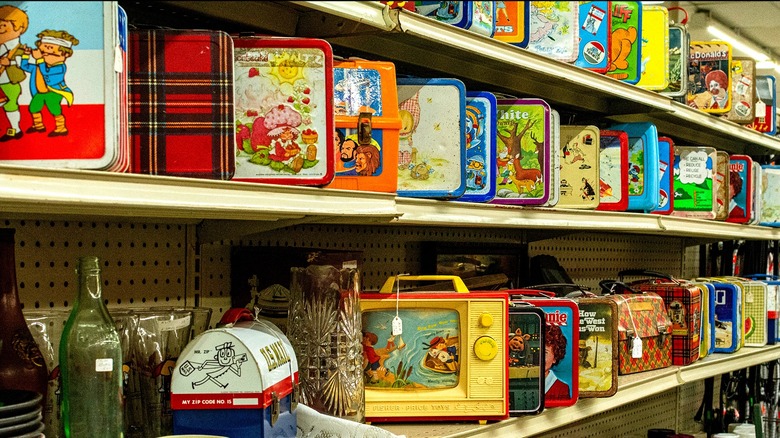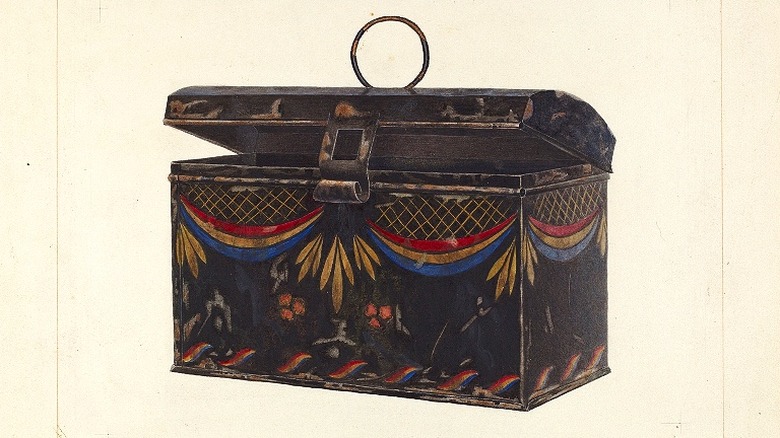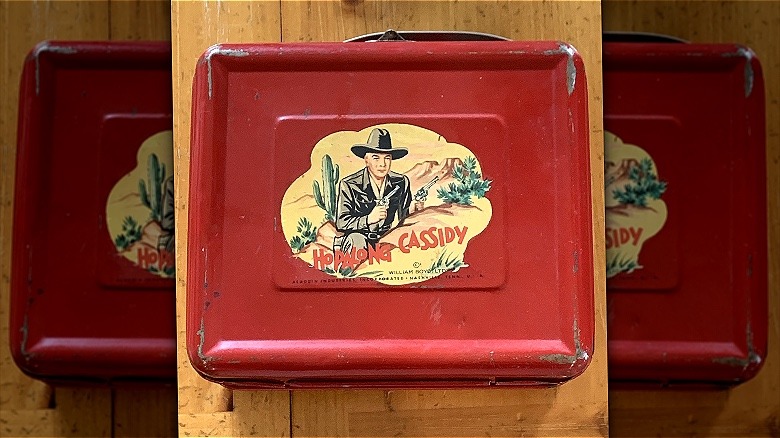Vintage Lunch Boxes That Could Be Worth A Ton Of Money Today
What exactly is the appeal of a lunch box? They are, after all, literally a box, or a pail, for carrying food. A metal or a plastic box with some decoration on it might look better than a paper bag, but it's still a utilitarian tool, with no particular reason for being specifically a lunch box. And yet, since the turn of the century, lunch boxes have been manufactured as a designated item with colorful designs.
As for many vintage lunch boxes, the move to have licensed deals may have been more of a cynical marketing choice than a sentimental one — LunchBox.com credits the durability of the metal lunch box with driving down sales, forcing manufacturer Aladdin Industries to innovate in the 1950s — but whatever the motive, it set off a fad that held strong for around 20 years before fading out. Once the 1970s arrived, metal was out, plastic was in, and kids had other ways to celebrate their favorite TV shows and show off to friends.
There's been a bit of a lunch-box revival today; bento boxes, portable lunch bowls, and insulated cloth "boxes" are celebrated, though more for their utility than their appearance. As for the classic metal lunch boxes of mid-20th century America, they've joined the family of kitschy collectibles, alongside the likes of PEZ dispensers and Cabbage Patch Kid dolls. As is often the case with such collectibles, you'll likely get more nostalgic value from any old lunch boxes you might have than a big payout, but there are those rare few that could fetch over $1 million (or at least a moderately handsome profit).
Pre-1950s lunch boxes can go for a lot
The basic rules of thumb for collectibles still apply to lunch boxes: the older it is, the rarer it is, the better shape it's in, the greater the nostalgia factor, and the more all these elements align together, the more likely you are to make some good money off of it. But, as surprise lunch-box aficionado Dave Bautista explained to Complex (via YouTube), vintage metal lunch boxes are at a disadvantage when it comes to quality: Having been marketed to kids, who were more concerned with using their lunch boxes to eat (or fight with), it's hard to find any in mint or near-mint condition.
And if mint lunch boxes from their heyday as a kids' status symbol are difficult to find, it only gets harder once you go back to before the 1950s; older collectibles are always more difficult to come by. Partly for that reason, examples of what might be called the proto-lunch box, converted biscuit tins from the Victorian era or the first lunch tins from the 1900s, could deliver handsome sums if all the other collectible stars align.
An oval Mickey Mouse lunch box from 1935, for example, has been valued at $2,000, per History. Besides the nostalgia of its age, along with the charm of classic Mickey and friends, some collectors might value the 1935 Mickey tin for its place in history, as it's been described as the first licensed lunch tin, predating the big craze for them by 20 years.
Lunch-box prices vary widely from their heyday
The lunch-box craze that ran from the 1950s through the 1970s was largely built on pop culture as filtered through television. Beginning with Hopalong Cassidy, the stars of Western shows, cartoons, science-fiction, campy comedies, and advertising mascots had their likenesses plastered on the side of tin pails, with movie, comic book, and real-life figures thrown in for good measure. Quite a few collectors got into it thanks to a lunch box with a particularly beloved character on it.
The characters on the lunch boxes didn't all have equal representation, however, so don't count on nostalgia alone to drive up prices. The one who started it all, Hopalong Cassidy, was manufactured in such bulk that there are still too many of them around, even now, for their value to eke above $500. On the other hand, a space race-themed lunch box from 1963 (Orbit), with a pilfered image from National Geographic that earned manufacturer Thermos a cease-and-desist notice (as told by the Smithsonian), can go for ~$3,200 if in mint condition.
The price range for many of these vintage lunch boxes seems to be in the mid-three figures, to go with the occasional outlier, and the most valuable ones may surprise you. Dudley Do-Right wasn't exactly the breakout cartoon star of the '60s, but because of the comparative scarcity of lunch boxes made of him, one near-mint box went for over $2,900 on eBay. Even more obscure was Toppie the elephant, whose box you could only get through value stamps from Kroger stores in Ohio. Mint Toppie boxes are valued at $6,000.


